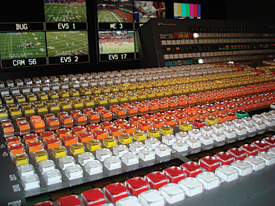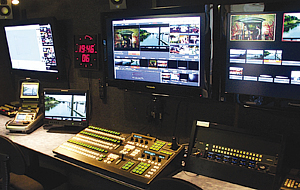Mobile Switchers Target Freelancers
RICHARDSON, TEXAS
The mobile production business is booming, with HD and the constantly growing demand for audience-building content. Broadcast switcher manufacturers are raising the bar with more features in a smaller footprint, in an effort to lure freelance operators from their Grass Valley comfort zone.
Currently, Thomson Grass Valley is the dominant supplier of switchers for mobile production. "We hold an 80 percent share in the American truck market over 40 feet," said Rick Paulson, senior product manager for Thomson Grass Valley. "The Kayak HD family is very strong in Europe, while Kalypso is the switcher of choice in America," he continued. "We do a really good job of paying attention to what works well in a live production environment. The majority of freelance operators are comfortable with the Grass interface and the way we've approached switching."
George Hoover, CTO of NEP Broadcasting, a Pittsburgh-based mobile production company with more than 20 trucks, agreed.
"Grass switchers are the industry standard for live remote production; our clients demand it," and there's the operational advantage of "interchangeable setups across the many mobile units used in major sports packages" such as NEP's recent Summer X-Games coverage for ESPN.
Paul Bonar, vice president of engineering for Game Creek Video in Hudson, N.H., concurred. The choice of switchers for their 11 HD and SD juggernauts "...is driven almost completely by our clients," Bonar said. "Over the years technical directors have become comfortable sitting behind Grass Valley gear; they are confident in its performance and familiar with its operation."
BASED ON TD FEEDBACK
When it comes to competition, Sony casts the longest shadow, Paulson acknowledged. Their switchers, "leveraged by a well-accepted camera line," according to Paulson, make Sony a serious contender in the large truck arena.

Game Creek's newest mobile production truck, Liberty, uses a Grass Valley Kalypso Sony's flagship switcher, the MVS-8000G Series, "offers a modular panel design for tight truck spaces, reduced power consumption, sophisticated external device control, Sony's Shot Box with multiple snapshot registers and editable timeline effects, plus a variety of creative enhancements based on real-world TD feedback," according to Product Marketing Manager Chris Marchitelli. Sony recently sold three HD switchers in a package for ESPN's new L.A. Live studios slated for completion next year. While not a mobile system per se, it's a noteworthy departure for the sports mega-business.
"Sony cracked the 'customer demands' problem by providing operator training; others like Ross are doing the same," according to Ron Crockett, president of truck builder Shook Mobile Technology in San Antonio, Texas. "We're seeing clients ask for 'a product in the Grass Valley range,' but there are several switchers competing with that," he said. "The younger guys aren't as entrenched; competitors have designed their switchers to emulate what Grass does, so the learning curve is not so difficult."
For Canada's Ross Video—a growing force in the mobile segment—operator familiarity is a major challenge, according to company President David Ross.
"There is no market more resistant to change than trucks that cater to freelancers," he said. "On the other hand, trucks or facilities that have full time TDs on-staff are usually very open to choosing the best switcher for the application."
Columbia College in Chicago recently installed a Ross Vision 3 switcher onboard its new 25-foot truck. The HD unit was built in-house, supervised by Dave Mason and Brett Johnson, chief engineer of television and of audio arts & acoustics respectively, with "a little help from their friends" at local ABC affiliate WLS.
"Columbia already had two Synergy switchers in fixed studios," Mason said. And while "it was built for education, not to be [a] rentable truck," according to Mason, WLS does rent it—with student production assistants—for local event coverage.
At Rogers TV, an Ottawa, Ont.-based station group, the Vision "allows us to further boost the production quality of broadcasts from our truck," said Pierre Fortin, director of planning and engineering. "We can execute complex event sequences at the touch of a button, offering our viewers some pretty cool visuals, and that's important to us when we're switching live."
Another emerging provider of switchers for mobile production in the United States, U.K.-based Snell & Wilcox has "...seen extraordinary success with the Kahuna across a broad variety of live production applications in OB [outside broadcast] trucks, arenas, news and studio production facilities, and at various live events, including the Beijing Olympics, in which more than a dozen Kahuna switchers were used," said Joe Zaller, vice president, corporate development. "Its unique FormatFusion technology enables it to handle any SD or HD format simultaneously, eliminating the need for external converters and their associated cost, weight, space and power requirements—all critical factors in the OB environment."
BANG FOR THE BUCK
In the booming smaller truck and flypack market, the Grass operator imperative retreats in favor of "bang for the buck" and inclusive feature sets from the likes of Broadcast Pix, Echolab and For-A. "We keep an eye on all those guys," Thomson Grass Valley's Paulson said. "They do some interesting things; competition is increasing in numbers and innovation."
Reenergized 34-year industry veteran Echolab offers numerous convenient features in a compact and intuitive switcher that operators new to a truck can master quickly, according to company President Nigel Spratling.

ABS' Truck B houses a Broadcast Pix 5016 switcher "Advanced transition, layering and keying features simplify the application of complex effects during live production," Spratling said. "Customizable RGB mnemonics [key color groupings] and user-definable graphic macro keys allow users to work according to their personal preferences, while internal conversion and synchronization help maintain quality while reducing the equipment required for SD/HD production."
Ryan Altschul, project manager for New Jersey-based Starlite Productions installed an Opera in its rental flypack based on its speed and operational flexibility, blended inputs/outputs, broadcast quality and affordable cost.
"The internal routing is so efficient we opted not to purchase an external SDI router," Altschul said. "Producers often ask for last minute ISOs, a different program in the main room than overflow, a clean feed to the satellite with a dirty feed to tape, for example. The Echolab handles all these situations at the push of a button." Starlite will soon follow Echolab's upgrade path to the new Overture.
For-A, another longstanding contender, highlights its compact switchers for mobile production.
"There's a lot of interest in trying to pack a lot of capability into the smallest footprint, obviously for fuel conservation and cost of operation; we tend to use the device that takes up the least real estate, such as the For-A," said Shook's Crockett.
"Mobile users like our small size, simplicity of design and reliability," said Susumu Hotta, president of For-A America. "Our easy to learn interface allows new operators to feel comfortable very quickly; some of our smaller switchers have been used on large trucks for secondary feed or video playback operations."
Moving production switchers into a 3-Gig future is on the minds of a number of manufacturers, including For-A, which has introduced its own advanced design with 3-Gig HD processing, "The HVS-5000 series is probably the only switcher on the market capable of 1080p/60 operation," Hotta said.
Thomson Grass Valley is taking "a wait and see" approach to 3G, according to Paulson.
"We won't be the first to market, but will take advantage of newer technology when demand catches up," he said. The Slate series from relative newcomer Broadcast Pix in Billerica, Mass., is especially suitable for mobile production because "they are an entire live video production system that occupies very little space," according to President Ken Swanton.
"A single operator or small team can create highly compelling video that previously could only be done with a much larger crew; just four rack units contain a switcher, CG, clip store and multi-viewer," he said.
Mark Siegel, a Broadcast Pix customer and president of Seattle-based Advanced Broadcast Solutions was looking for a very cost-effective "beer budget" solution.
"I built a high definition truck—not for high-end sports, [but] more for entertainment, concerts, special events or parades. I primarily built it to assist the broadcasters in my market," Siegel said. "Broadcast Pix puts a lot of devices under one control—it offers many more features than a traditional production switcher. If a TD knew he was going to switch on one, he could get a live demo on their Web site before he got to the jobsite."
The mobile production's growth forecast is significant, according to Crockett.
"The real issue is programming," he said. "The majority of programming that's really interesting—and that happens to be sports and documentary and other types of production—are going to be done in a mobile environment."
Game Creek's Bonar agrees. "We are going to require switchers to do more, create more and do it faster and easier; all without losing sight of the fact that someone has to sit in front of the console and do it without making a mistake."
The professional video industry's #1 source for news, trends and product and tech information. Sign up below.
